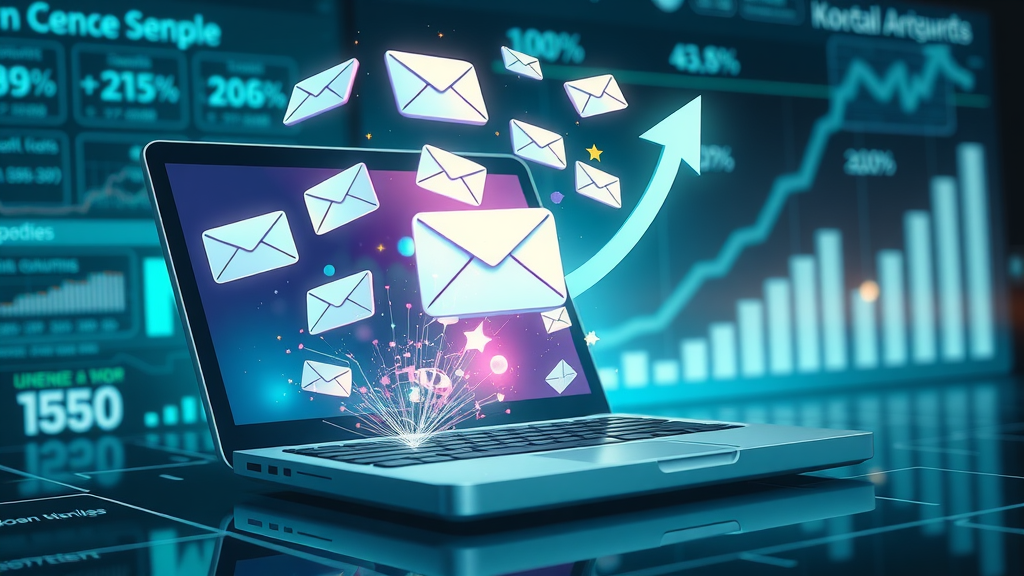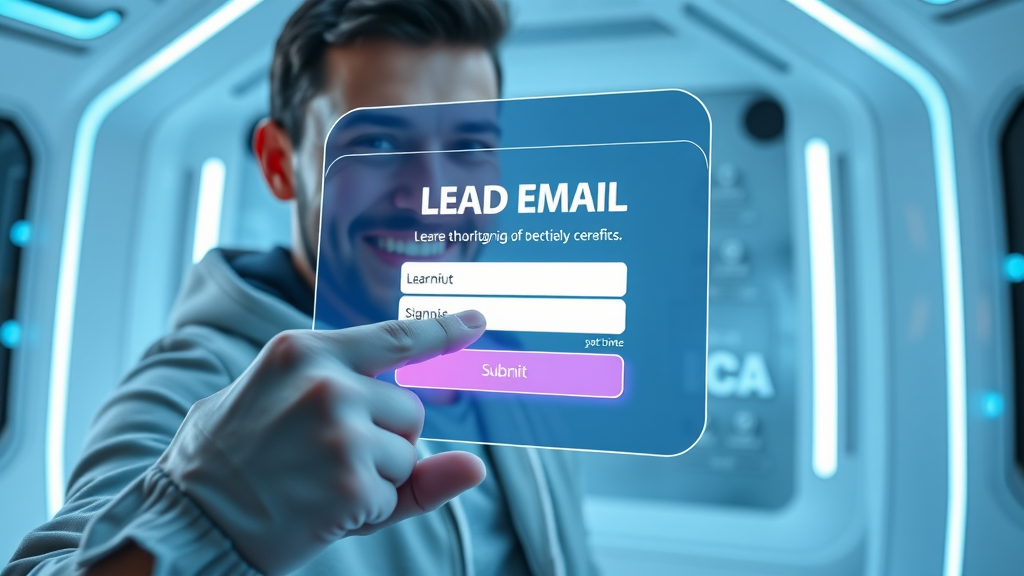Imagine doubling your open rates and seeing your click-throughs soar—automatically. Did you know that over 50% of businesses now attribute their ROI growth directly to email marketing automation ? If you want higher engagement, smarter marketing, and rapid business growth, this is your roadmap to unlocking the full potential of email marketing automation . Dive in to discover proven strategies, features, and tools that'll turn every email send into measurable business results.

Why Email Marketing Automation Delivers Exceptional Results
A Surprising Fact: Over 50% of Businesses Attribute Their ROI Growth to Email Marketing Automation
- Rapid increase in email open rates using automation software.
- Dramatic improvements in click-through rates with email marketing automation strategies.
- How personalized automated emails impact customer engagement.
The core advantage of email marketing automation lies in its ability to consistently deliver the right message to the right person, at the right time—without constant manual effort. Modern automation tools analyze audience behavior to send targeted, relevant emails that drive higher open and click rates. Instead of blasting your entire list and hoping for results, automation workflows segment your audience, personalize outreach, and trigger automated email responses that land when customers are most likely to engage. For example, a new subscriber might receive a welcome series, a shopper who abandoned their cart gets a friendly reminder, while loyal customers receive exclusive rewards—all hands-free, but deeply personal. This efficiency not only saves time, but also compounds over time, boosting ROI and customer lifetime value. With over half of modern businesses reporting ROI growth from automated campaigns, transitioning to an automation-first approach is no longer optional—it's essential to compete and thrive.

Benefits of Email Marketing Automation for Modern Businesses
Grow Your Business With Scalable Email Automation
- Streamline repetitive email sends for higher efficiency.
- Leverage advanced marketing automation tools to nurture prospects.
- Automate the customer journey and reduce manual effort.
With scalable email automation , even small businesses can compete with enterprise-level efficiency and sophistication. By streamlining repetitive tasks—like welcome emails, follow-ups, and post-purchase check-ins—you free up resources to focus on creative strategy and deepening relationships. Automation tools ensure each touchpoint is perfectly timed and relevant, nurturing leads without overwhelming your team with manual sends. Businesses leveraging this approach can efficiently guide customers through personalized journeys, from lead capture to post-sale engagement. Whether you're managing a small email list or sending thousands of messages daily, automation software expands your reach without expanding your workload, helping you grow your business with less stress and more results.
How Marketing Automation Outperforms Traditional Email Marketing
- Improved segmentation and personalization with automation software.
- Faster response times and reduced customer acquisition cost.
- Integration with marketing platforms and landing pages for greater results.
Traditional email marketing often relies on broad, generic blasts that offer little personalization or timely relevance. In contrast, marketing automation supercharges your strategy by enabling highly segmented campaigns and instant, behavior-based triggers. Automated emails respond quickly to customer actions—whether it's signing up on a landing page or clicking a special offer—helping you build loyalty and capture more sales. Automation software also lowers acquisition costs by nurturing leads throughout the customer journey, transforming prospects into customers at a fraction of the effort. Seamless integration with other marketing tools creates a unified communication and measurement hub, driving even greater results across your entire marketing platform.

Essential Features of Leading Email Marketing Automation Tools
Automation Workflow: Design Automated Campaigns That Convert
- Drag-and-drop automation workflow builders.
- Branched triggers for automated emails (abandoned cart, onboarding, retention).
- Reporting and analytics within the email marketing platform.
When evaluating an email marketing automation tool , prioritize robust automation workflow features. Intuitive builders make it easy to map out and automate complex journeys, so you can launch everything from simple drip campaigns to multi-branch nurture sequences. By incorporating triggers like abandoned cart reminders, event-based follow-ups, and onboarding series, these tools ensure every customer receives personalized, timely outreach without the manual hassle. Most leading automation software also includes deep reporting and analytics, so you can track opens, clicks, conversions, and more—all from within the email marketing platform. With continual optimization, you can fine-tune flows for maximum impact and ROI.
Robust Email Templates & Personalization Techniques
- Customizable email templates for branded messaging.
- Dynamic content blocks and sender personalization.
- Easy A/B testing within the automation tool.
Email templates are the backbone of every great automated campaign. Best-in-class email marketing platforms offer hundreds of professionally designed templates that reinforce your brand and adapt to any device. Dynamic content blocks and personalization tags create individualized experiences for every recipient—whether it's including a first name or tailoring recommendations by browsing history. Built-in A/B testing helps you experiment with subject lines, layouts, and calls to action, ensuring every automated email is optimized for the highest open and conversion rates possible. With these features, your campaigns look fantastic and perform even better.

Integrations With Popular Marketing Automation Platforms
- Connect your email automation with CRMs and eCommerce tools.
- Sync automated email sends with landing page campaigns.
- Incorporate marketing platforms for a seamless workflow.
Seamless integrations are a game-changer in email marketing automation . Modern tools let you sync with CRMs, eCommerce platforms, and landing page builders, streamlining every part of your campaign. This connectivity ensures that data flows effortlessly between systems, allowing you to trigger emails when prospects fill out a landing page form or make a purchase, and keeping your email list up-to-date and relevant. Leading automation software even connects with marketing analytics suites and social media ads, enabling complex, multi-channel workflows—all easily managed from one dashboard.
"The right email marketing automation tool empowers marketers to build lasting relationships through personalized, timely outreach." – Digital Marketing Expert
How to Set Up Your First Email Marketing Automation Campaign
Building Your Email List With Automation Tools
- Use landing pages and forms to capture leads.
- Automate welcome email sends for new subscribers.
- Employ engaging email templates to elevate onboarding.
Your email list is the foundation of every marketing effort. Start by creating high-converting landing pages and signup forms to capture new leads. Modern automation tools instantly add subscribers to your email list and trigger personalized welcome sequences—making every new contact feel valued from day one. With compelling email templates and automated onboarding, you ensure prospects engage right from the start. Automated emails provide timely resources, set expectations, and gently nudge recipients toward their first conversion.

Creating an Effective Automation Workflow
- Map out the customer journey.
- Define automated triggers and conditions.
- Schedule timely, relevant automated emails.
Effective automation workflows mirror the unique paths customers take to conversion. Start by mapping your ideal customer journey: from the first signup through nurturing, onboarding, and repeat purchase. Next, set up triggers and rules—such as sending a thank you after a download, or a follow-up to those who left a shopping cart behind. Finally, schedule relevant email sends to keep your audience informed and engaged at every stage. With automation software, you can replicate these workflows at scale, delivering every message precisely when it matters most.
Optimizing Email Templates for Automation Success
- A/B test subject lines for maximum email opens.
- Tailor automated emails by user behavior and segment.
- Refine automated follow-ups for higher conversions.
Optimization is an ongoing process in email marketing automation . Use easy A/B testing to identify which subject lines and content boost open and click-through rates. By segmenting your audience and personalizing based on behavior—like purchases or page views—your emails feel more relevant and less like generic blasts. Refine your automated follow-up series regularly, using analytics to identify bottlenecks and opportunities, ensuring each campaign iteration outperforms the last.

Video Walkthrough: Setting Up and Using Email Marketing Automation Software
Watch: Step-by-Step Guide to Launching Your First Automated Email Campaign
For those who learn visually, watch our comprehensive video guide. You'll discover how to select the right automation software, build workflows, create branded email templates, and analyze results—all in easy, actionable steps. This hands-on walkthrough ensures you'll launch your first automated email campaign confidently and quickly, no matter your skill level.
Choosing the Best Email Marketing Automation Software for Your Needs
Comparing Top Marketing Automation Tools and Platforms (Table)
| Name | Free Plan | Email Sends | Advanced Automation | Integrations |
|---|---|---|---|---|
| Tool A | Yes | 10,000/mo | Yes | CRM, eCommerce |
| Tool B | Yes | 5,000/mo | No | CRM |
| Tool C | No | 20,000/mo | Yes | eCommerce, Webinar |
Features to Consider in Automation Software
- Free plans and scalability.
- Ease of use and automation workflow flexibility.
- Integration with your existing marketing tools and platforms.
Choosing the right email marketing automation tool can make or break your campaign strategy. Look for tools that offer a free plan so you can test features and scalability as your business grows. User-friendly workflow builders are essential, as are robust template libraries and analytics dashboards. Integration capabilities ensure you can connect your email workflows to CRMs, eCommerce, or webinar platforms, creating seamless cross-channel marketing. Review pricing, customer support, and community resources before committing to maximize your automation software investment.
Maximizing Engagement: Email Send Timing, Frequency, and Personalization
Best Practices for Automated Email Sends
- Schedule email sends when your audience is most active.
- Personalize email content for different segments using automation.
- Test email send frequency for optimal engagement.
Timing and personalization are two of the biggest engagement drivers for automated emails. Use your automation platform to analyze when your subscribers are most likely to open and interact, then set your campaigns to launch during these high-activity windows. Personalizing subject lines, messages, and offers based on out-of-the-box segmentation capabilities further increases relevance and response. Continuous testing—on timing, frequency, and content—will quickly reveal the sweet spot for your audience, allowing you to maximize opens, clicks, and ultimately, conversions.

Retention and Recovery Campaigns: Abandoned Cart and Re-Engagement with Email Automation
Recover Lost Revenue with Automated Cart Abandonment Emails
- Automated follow-up sequences for abandoned carts.
- A/B tested email templates to boost recovery rates.
- Tracking analytics on email open and click-through rates.
Cart abandonment is a revenue leak you can't afford to ignore. With email automation , you can instantly trigger personalized follow-ups when a shopper leaves their cart. These campaigns use proven email templates —often optimized through A/B testing—to remind, incentivize, and guide shoppers back to their purchase. Automation software tracks which emails are opened, which links are clicked, and ultimately, how many carts are recovered—empowering you to refine your campaigns and grow your bottom line with every send.

Re-Engagement Campaigns for Inactive Subscribers
- Automated win-back email sends for dormant users.
- Personalized content and incentives using marketing automation.
- Measure the impact with marketing automation software analytics.
Not all subscribers stay engaged forever—but email marketing automation gives you a second chance. Launch automated re-engagement or win-back campaigns targeting those who haven't opened or clicked in a while. Personalize the message with special offers, exclusive content, or sincere requests for feedback to re-ignite attention. Use your marketing automation platform’s analytics to track responses and adapt your approach over time. By proactively reconnecting with dormant contacts, you reduce list churn, recover lost revenue, and restore valuable relationships.
Monitoring, Analyzing, and Improving Email Marketing Automation Performance
Key Metrics: Track Email Opens, Clicks, and Conversions
- Monitor open rates for every automated email.
- Track click-through rates and conversions across campaigns.
- Use your automation software’s analytics dashboard for ongoing optimization.
Consistent measurement is crucial for ongoing success. The best email marketing automation platforms feature real-time dashboards that let you monitor key performance indicators like open rates, click-throughs, and conversion rates for every automated email. Use these insights to identify trends and optimize future campaigns. High-performing automation tools often include predictive analytics, illuminating which audience segments, subject lines, or offers are moving the needle—and where micro-adjustments could fuel even better results.

Continuous Improvement with Automation Tools
- Use automation workflow insights to refine campaigns.
- Leverage predictive analytics for smarter segmentation.
- Iterate based on real-time performance reports.
Continuous improvement is what separates good campaigns from extraordinary ones. Dive into workflow analytics to see where leads drop off or convert, then tweak triggers, timing, and content accordingly. Predictive models help you sharpen your segments—ensuring the right automated email finds its way to the most receptive audience. Regular iterations, based on current performance metrics, allow you to evolve your strategy, resulting in ever-higher engagement, retention, and ROI over time.
Case Study Examples: Real Results Achieved With Email Automation
"After implementing automation, we increased our open rates by 40% and doubled conversions." – E-commerce Manager
Real-world results prove the power of email marketing automation . See how top brands boost engagement, drive more revenue, and streamline operations by implementing smart, scalable workflows. These case studies show that when executed well, automation can transform your marketing, freeing your team’s time and multiplying your results.
Key Factors for Choosing a Marketing Automation Tool
- Robust library of email templates and automation workflows.
- Seamless integration with your existing marketing platform.
- Transparent pricing and responsive support.
The best marketing automation tool should match your business goals, technical expertise, and budget. Prioritize platforms that offer broad template libraries , advanced automation workflows, and tight integrations with your marketing stack. Transparent pricing ensures scalability, and dedicated support means you won't face growing pains alone—making it easy to adapt as your campaigns become more complex.
Popular Questions About Email Marketing Automation Answered
What is automation in email marketing?
- Automation in email marketing involves using software to schedule, personalize, and trigger emails automatically based on specific rules or user behaviors, making campaigns more efficient and scalable.
What is the best email marketing tool for automation?
- The best tool depends on your needs. Look for marketing automation software offering a free plan, powerful automation workflows, and integrations with your core platforms. Top options include Mailchimp, HubSpot, and ActiveCampaign.
What are the 5 T's of email marketing?
- The 5 T's: Tease, Target, Teach, Test, and Track – all essential for successful automated email campaigns and optimizing marketing automation results.
How to set up automated marketing emails?
- Select an email marketing automation software, map your audience journey, design automation workflows, customize email templates, schedule email sends, and analyze the results for continuous improvement.
FAQ: Your Top Email Marketing Automation Queries
Can I use email marketing automation for small businesses?
- Absolutely. Automation software scales to fit any business size and offers free plans to get started.
How do automated emails integrate with landing pages?
- Automated emails can trigger when leads submit landing page forms, starting a targeted email nurturing sequence and boosting conversions.
What metrics matter most for automated email sends?
- Focus on open rate, click-through rate, and conversion rate. Use detailed analytics from your marketing automation platform to measure success.
Expert Strategies for Power Users of Automation Software
- Using advanced segmentation in marketing automation tools.
- Personalizing with behavioral triggers and predictive analytics.
- Automating multi-channel touchpoints with email marketing automation and social ads.
Ready to go beyond the basics? Leverage advanced segmentation, AI-driven analytics, and behavioral triggers to make each campaign smarter. Top-performing marketers are now using automation to drive not just emails, but coordinated social ads and retargeting—delivering a seamless, multi-channel experience that keeps your brand top of mind and boosts engagement across every digital platform.
Ready to Grow Your Business With Email Marketing Automation?
- Book your free marketing strategy session—maximize opens, clicks, and conversions. Call: 314-560-4642 or visit https://marketingconnectionsllc.com/get-in-touch
Summary of Key Takeaways on Email Marketing Automation
- Email marketing automation boosts engagement, efficiency, and ROI.
- Automated workflows facilitate better segmentation and personalization.
- Top automation software offers free plans, powerful templates, and seamless integrations.
- Continuous optimization is key to long-term results.
Ready to grow your business and connect with more customers? Book your free marketing strategy with our team today. Call: 314-560-4642 or visit: https://marketingconnectionsllc.com/get-in-touch
To enhance your understanding of email marketing automation, consider exploring the following resources:
-
“Email Marketing & Automation Software | ActiveCampaign” : This resource provides insights into how ActiveCampaign’s automation-first approach can help deliver personalized experiences, increase open rates, and engage your audience effectively. ( activecampaign.com )
-
“Email Marketing Automation Software by Zoho | Boost ROI & Save Time” : This page discusses how Zoho Campaigns’ email automation software can help automate repetitive tasks, boost engagement, nurture leads, and maximize conversions, thereby improving customer experience and increasing your bottom line. ( zoho.com )
If you’re serious about leveraging email marketing automation to boost your business’s engagement and efficiency, these resources will provide you with valuable insights and tools to get started.
 Add Row
Add Row  Add
Add 






Write A Comment